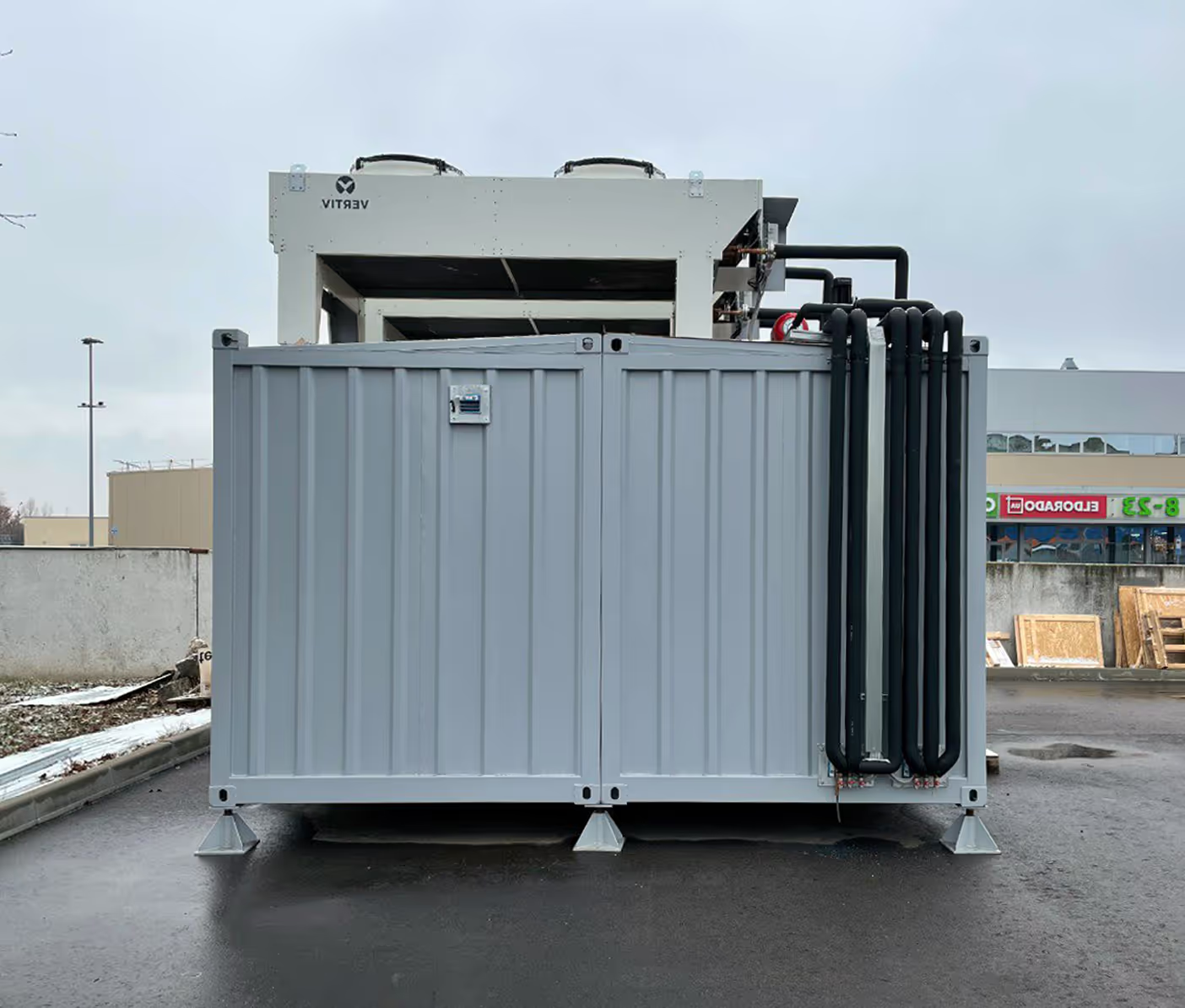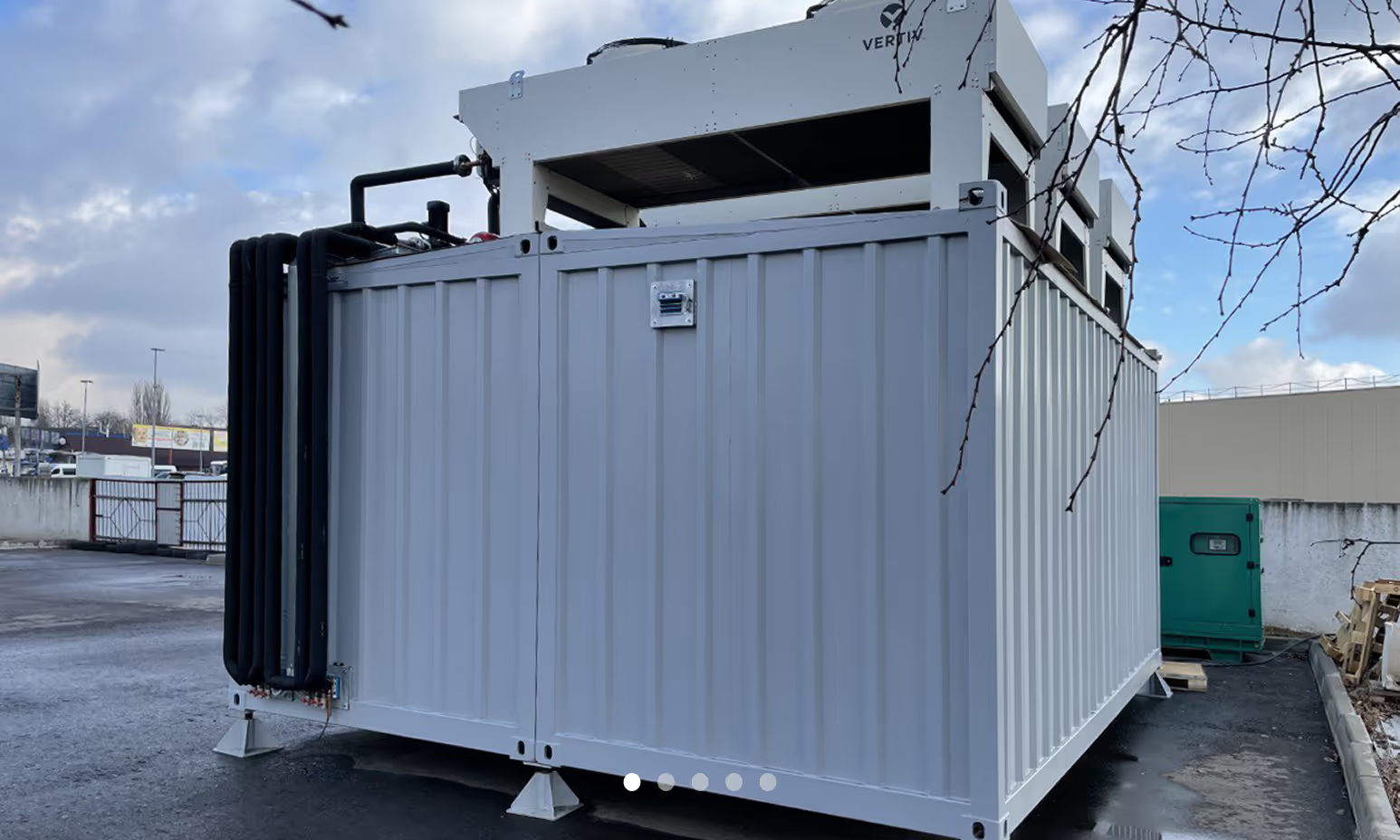Eastern Europe
Indirect Free Cooling MDC in Dense Urban Courtyard
Two shortened modules providing 35 kW IT load with indirect free-cooling, engineered to pass through a narrow archway and operate inside a historic courtyard.
Book a 30-min call

Context
The client required a resilient on‑prem compute adjacent to their HQ yet could not renovate the historic building or place equipment street‑side.
The only feasible location was a walled inner courtyard accessed via a narrow archway – imposing strict limits on module length and height while keeping standard width for road logistics. Energy efficiency was a procurement priority, with preference for “green” operation during the region’s long cool season.
At a glance

Customer
Government entity, Eastern European capital (anonymized)

Use case
Energy‑efficient edge compute in a constrained, inner‑courtyard site

Outcome
Tier III ready MDC with indirect free‑cooling provides energy savings during the cold/cool seasons

IT capacity
35 kW across five racks

Time‑to‑deploy
~5 months (design → build → FAT → commissioning)

Transport & siting
Custom modules sized for archways and standard road‑legal width access
Challenges
Tight urban access
Single access route under a low, narrow arch; limited turning radius inside the yard
Continuity
High availability (concurrent‑maintainable power/cooling) with clean agent fire suppression and monitored access
Energy policy
Preference for low‑OPEX cooling for most of the year
No building works
Historic façade and protected utilities ruled out major civil reconstruction
Solution
A two‑module MDC using indirect free cooling (IFC). Each module kept standard container width for public‑road transport but shortened overall length to pass the arch and manoeuvre within the courtyard.
Roof structures were engineered to support dry coolers, and the mechanical/electrical plant was integrated at the factory. The MDC was placed on pads inside the courtyard, adjacent to the main building for short network runs and simplified security.

Key features
— Siting & logistics
Modules sized to clear the arch; standard width retained for road legality; yard installation with no façade reconstruction.
— Power
Modular UPS providing ~10‑minute autonomy at design load; automatic transfer to on‑site generator; 2N power distribution to racks.
— Fire & safety
Early‑warning smoke detection, clean‑agent fire suppression, non‑combustible interior finishes.
— Security & monitoring
Role‑based access control, CCTV, environmental and plant monitoring with alerting.
— Cooling (deployed)
Three cabinet CRACs with indirect liquid free‑cooling and DC‑inverter fans/compressors; N+1 redundancy.
IFC mode uses ambient conditions to reject heat via roof‑mounted dry coolers without bringing outside air into the IT space.
Custom engineering

Short‑body modules
Custom shorter‑than‑ISO length with structural reinforcement allowed navigation through the arch and tight inner yard.

Engineered roof & joints
Purpose‑built roof with slope, load bearing for dry coolers, and weather management; joining nodes designed for precise mating and long‑term rigidity.
Results

Energy efficiency
IFC mode enables compressor‑off operation through much of the year in this climate, reducing electrical consumption vs. DX‑only.

Urban fit
Delivered resilient capacity inside a courtyard without altering the historic façade or requiring oversize transport.

Lifecycle flexibility
The MDC remains redeployable; modules can be extracted the same way they entered.
Specs snapshot
Racks
5×
42U
IT load
35 kW (this
deployment)
Cooling
Indirect free cooling (dry coolers on roof), N+1, DC‑inverter controls
Power path
2N distribution; modular UPS; ~10‑min autonomy at design load; on‑site generator integration
Fire & safety
Early smoke detection; clean‑agent suppression; non‑combustible interior materials
Security/monitoring
Access control, CCTV, infra & environmental telemetry with alarms
Business value and fit

Value
Lower OPEX during cool/cold seasons without compromising cleanliness of the white space; reusable asset that avoids stranded CAPEX in historic cores.

Ideal for
Dense urban sites with access constraints (archways/back‑lots).

Not ideal for
Hot climates with limited cool months.
FAQ
What is a modular data center?
A modular data center (MDC) is a prefabricated, container-based data center that integrates racks, power, cooling, and security systems inside portable enclosures. Unlike traditional on-site construction, a containerized modular data center is factory-built, tested, and shipped ready for installation. ModulEdge designs scalable modular data centers from 5–50 kW per rack with DX, chilled-water, adiabatic, and free-cooling options — engineered for edge and AI workloads where reliability and low latency matter most.
Why consider a modular data center?
A container modular data center enables faster deployment, lower risk, and predictable performance compared to conventional builds. Prefabricated and tested in the factory, these systems minimize site work and allow operators to scale step-by-step as demand grows. Organizations in telecom, industry, energy, and defense choose mobile and containerized data centers to place compute closer to operations, improve resilience, and maintain on-prem control of sensitive workloads. ModulEdge’s portable modular data center solutions combine EU engineering with ruggedized designs for harsh conditions.
How are modular data centers different from traditional data centers?
Traditional data centers are built on-site, requiring long construction cycles and multiple contractors. A prefabricated modular data center is built in controlled factory conditions, integrating power, cooling, fire suppression, and monitoring systems before shipment. This approach cuts deployment from years to months, ensures quality through FAT/SAT testing, and allows redeployment when operations move. ModulEdge’s containerized data center infrastructure offers the same Tier III/IV design principles as conventional facilities — with faster rollout, lower cost, and modular scalability.
Are you Tier III certified?
Our modules are designed to meet Tier I - IV principles. Certification applies to a specific site and build; we support auditor engagement for deployments that pursue certification.
Do you support AI training clusters?
No. We position for edge AI inference at ≥40 kW per rack. Training‑class densities (≈120–150 kW/rack) are not feasible in this form factor.
What’s the typical lead time?
Custom builds: 3–6 months. Commissioning depends on scope and site readiness (power, pad, network). We’ll confirm a schedule during design review.
How do you handle hot or variable climates?
We match DX, chilled‑water, adiabatic, or free‑cooling to your climate and energy costs, targeting predictable efficiency (modeled PUE) and thermal headroom.
Can the modules handle harsh environments?
Yes – dust/sand/humidity hardening, vibration tolerance, and optional EMP shielding are available to maintain uptime in demanding sites.
Will this integrate with our existing monitoring and access control?
Yes. We deliver integrated monitoring and access/CCTV and align interfaces during design review to fit your tooling and security policies.
Can we redeploy modules later?
Yes. Standard 20‑ft and 40‑ft footprints with a redeployable approach; we provide rigging/placement plans and support relocation.
Do you sell direct or via partners?
We’re partner‑first (OEM/whitelabel and system integrators). End‑user projects are delivered with or through partners.